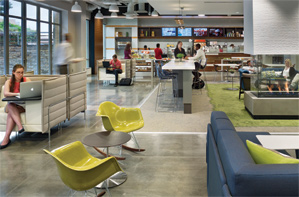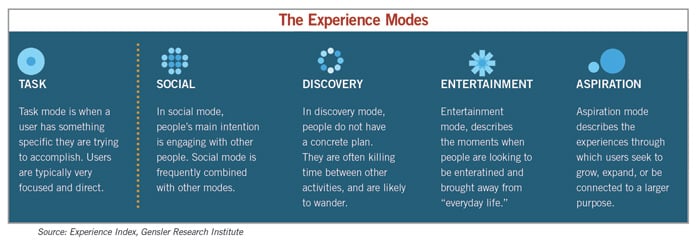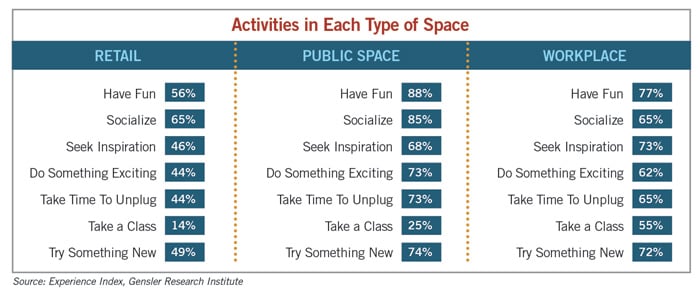Designing Spaces to Create Great Experiences

A Gensler study quantifies that the right design can result in great experiences, which in turn are great for business.
TODAY, THE GOAL of every project that forward-thinking architects design is to give people positive experiences. Clients in every sector, including commercial real estate, are struggling to keep up with the dramatidec evolution of how people work, live and shop today – and those who aren’t are sacrificing business performance. To better understand – and to quantify – the link between design and delivery of a great experience, Gensler developed the Gensler Experience Index, a first-of-its-kind mixed-methods research approach to create a holistic Experience Framework for understanding experience and quantifying the effect of design on that experience.
The Gensler Experience Index is the result of a rigorous investigation that combined qualitative ethnographic research with quantitative research to identify the design factors that are most important in creating exceptionally great spaces and places. After several years, five roundtables, 60+ hours of one-on-one ethnographic observations and a survey of more than 4,000 consumers, the Gensler Experience Index quantifies and brings greater depth to what many in the design industry already knew instinctively – that great design is an important component of great experiences.
Five Modes of Experience
How should commercial real estate developers and property owners focus on experience, and how can design help? The first step is understanding human intentions. A key finding of Gensler’s research is that the reason people visit a space frames the type of experience they expect.
Are they there to pick something up and leave? Are they there to browse and be inspired or to grab dinner with a friend? Whether it’s for a customer, an employee or a guest, design can be the differentiator between a good, bad or great experience.
Gensler organizes these intentions into five “modes” of experience: 1) task, 2) social, 3) discovery, 4) entertainment and 5) aspiration. These modes serve to help one better understand human behavior and expectations. This knowledge enables developers and designers to create better spaces, resulting in better experiences.
Whereas the five modes represent distinct user intentions and mindsets, that doesn’t mean people stay in one mode during a given experience. The ability to switch modes easily is a key aspect of a great experience.

Doing Everything, Everywhere
The lines between work, play and life have blurred, and these are no longer distinct activities. Places designed to accommodate multiple actions – from working to socializing to exercising and everything in between – are far more likely to offer great experiences.
Higher employee engagement has been shown to increase company innovation and business success, creating a strong business case for investing in workplace design. It’s not enough to design a workplace for just work activities. A positive employee experience depends on well-designed spaces where employees can connect, unplug and be inspired. That means allowing and accommodating the “blur” of non-work activities that occur during the workday. Nearly all employees do non-work activities at work, and they report a better workplace experience as a result.
Ignore Social Space At Your Peril
As people spend more time online, they increasingly seek places to connect in real life – and for good reason. Loneliness and social isolation have become recognized as health epidemics, spurred by a growth in social media and a concurrent lack of depth in social connection and communication. Gensler’s data underscore both the prevalence and the importance of the social aspects of experience. People crave community, connection and belonging, and are seeking out places to connect.
This heightened need for interpersonal connection may mean allocating greater space specifically for that purpose and creating places that build community and interaction. Some of the biggest opportunities to improve may be at work. While social spaces have been proven to boost both employee engagement and performance, companies and workers consistently undervalue the benefits of socialization to their overall work productivity.
Six Design Factors
The relationship between a great experience and business performance is well documented – multiple studies have connected the overall quality of customer or employee experience to a company’s long-term stock performance and growth. The measurable effect of design and physical space is, however, frequently left out of the equation, and most companies have no systematic approach to creating a differentiated strategy for creating customer, visitor or employee experiences.
To get to the bottom of this connection, Gensler explored the effect of specific design factors on experience. From among the 75+ design factors studied in the survey, six emerged as having the most significant bearing on experience: 1) beauty, 2) novelty, 3) authenticity, 4) clarity, 5) inspiration and 6) a sense of welcome. Importantly, these go beyond just functional factors; they are more experiential and speak to the overall impression a space makes on a visitor.
The potential effect is huge. For example, places with unique design features are dramatically more likely to be shared on social media and recommended to friends and family. Stores with unique features are shared 10 times more often, workplaces six times and public spaces three times.
The Gensler Experience Index also illuminated how careful design can directly and positively support people’s unstructured time or “discovery” time. Nearly three-quarters of shoppers who visit a retail store without the intent to purchase end up buying something if the store’s design is appealing. Additionally, employees who take time for breaks or to reflect are more engaged and have better workplace experiences. Businesses that don’t invest in design are overlooking an opportunity to improve sales, to build consumer loyalty and to engage employees.

The Future Is About Experience
The human experience must be the force behind the meaningful design of every space so that interactions, expectation and intentions – the elements that make up the Gensler Experience Framework – can come together to generate a meaningful encounter for each individual.
By Andy Cohen, Co-CEO, Gensler




